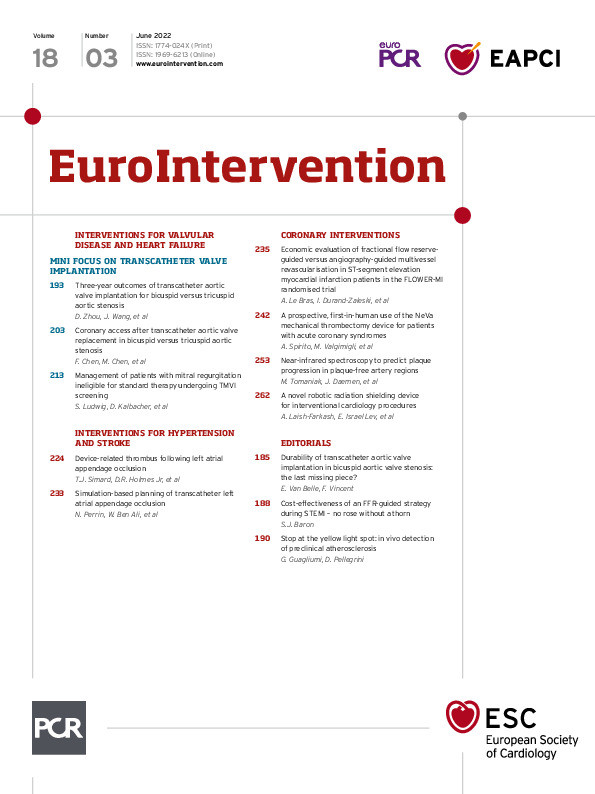The treatment of coronary artery disease has experienced a dramatic improvement in recent decades, but the early identification of atherosclerosis still remains an unmet need. Primary prevention relies on predicted cardiovascular risk, but subclinical lesions may be missed and aggressive control of risk may start too late, when vasculopathy has become clinically relevant. Thus, the availability of novel diagnostic tools for the early detection of atherosclerosis will play a crucial role in the improvement of patient management and social health.
Near-infrared spectroscopy (NIRS) is a valuable tool for a complete assessment of coronary artery disease, as it shows a high accuracy in the detection of lipid infiltration, and it is currently the only imaging technique able to provide a consistent and quantitative estimate. Coupled with intravascular ultrasound (IVUS), it can deliver comprehensive information about both the morphology and the composition of the vessel wall.
In the current issue, Tomaniak and colleagues1 have shown that NIRS is able to detect lipid infiltration even in coronary segments with a thin vessel wall, which may otherwise be deemed healthy by IVUS. In the study, over a 12-month follow-up, the areas with abnormal NIRS, despite having thin vessel walls, showed a higher increase in wall thickness compared to areas with normal NIRS, thus hinting at an early stage of atherosclerosis, where abnormalities may be chemical even before being physical. As the authors state, this evaluation is possible with optical coherence tomography (OCT) as well, which was used as a reference in the study. However, unlike OCT, NIRS does not require particular skills in image acquisition or interpretation, it suffers from only marginal heterogeneity, and it conveys a quantitative assessment of the lipid burden.
These results may lead to interesting scenarios. Recently, two different publications have shown that aggressive lipid-lowering with PCSK9 inhibitors reduces plaque burden and lipid infiltration and increases fibrous cap thickness, with potential impact on plaque stability and future adverse events23. Indeed, the most interesting target for this intervention aimed at plaque regression may not be the large, vulnerable fibroatheroma, but the early, subclinical plaque. A careful selection of subjects with preclinical atherosclerosis may help maximise the effect and the cost-effectiveness of these expensive drugs. Nevertheless, one may doubt whether these lipid spots in thin-wall vessels are sufficient to consider an otherwise healthy patient as affected by vascular disease, and justify an aggressive lipid-lowering therapy with very strict cholesterol targets as recommended by guidelines4. Large randomised controlled trials should be performed to address this statement.
The authors should be commended for this high-level, mechanistic research involving a complex and accurate methodology. The great effort of employing multiple imaging techniques at different times required a careful selection of optimal frames for analysis, meticulous coregistration, along with procedures to reduce heterogeneity. Manual postprocedural alignment of discrete landmarks still warrants a word of caution, as it requires significant skill, is time-consuming, and may produce a certain grade of uncertainty. It is, however, currently unavoidable, considering the lack of automated processes to coregister multiple tomographic (either single or multimodal) acquisitions during interventional procedures. Future development of catheters capable of simultaneous OCT and IVUS imaging, as well as fully automated processes for the alignment of vascular images supported by artificial intelligence and based on robust lumen algorithms may represent a critical improvement.
However, two final sobering words should be spoken on the impact of these findings on daily practice. First, the multimodal methodology of this study clashes with current practice, where the usage of intracoronary imaging is still unacceptably low, and many interventional cardiologists rely on coronary angiography alone. Second, it would be unlikely to justify an invasive procedure (with related risks and costs) in an otherwise healthy patient, for the sole aim of prevention.
For this reason, the results of this study are not critical per se, but are important for the paradigm shift they introduce: imaging in the field of atherosclerosis is not only limited to treatment, but it can be a tool for prevention. The big challenge will involve the application of this concept to non-invasive imaging such as coronary computed tomography (CT). Indeed, CT is already able to detect tissue oedema and identify inflammatory, vulnerable plaques5. Being able to quantify lipid content will surely take time, but it may not be so far away.
Conflict of interest statement
G. Guagliumi received grants from Infraredx; and consulting fees from Infraredx and Abbott Vascular. D. Pellegrini has no conflicts of interest to declare.
Supplementary data
To read the full content of this article, please download the PDF.

